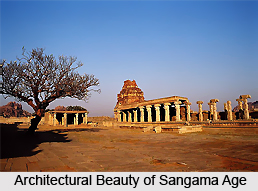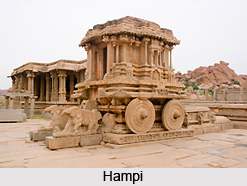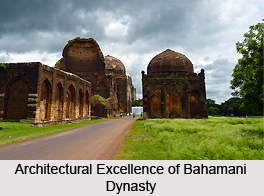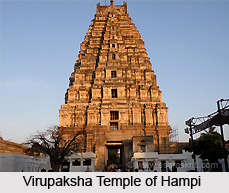 The Sangama dynasty was named after Sangama who belonged to the Yadu family and was in close connection with the Hoysalas. The Sangama dynasty was the cultivation of his successors named Harihara, Kampa, Bukka, Marappa and Muddappa. Sangama remained the governor under Hoysala kings and was in charge of the territory around Shimoga. After Sangama, his eldest son Harihara was appointed as the Great Provincial Governor or the "mahamandaleshwara" by the Hoysala king Vira Ballala and was given the authority to supervise the northern part of his kingdom.
The Sangama dynasty was named after Sangama who belonged to the Yadu family and was in close connection with the Hoysalas. The Sangama dynasty was the cultivation of his successors named Harihara, Kampa, Bukka, Marappa and Muddappa. Sangama remained the governor under Hoysala kings and was in charge of the territory around Shimoga. After Sangama, his eldest son Harihara was appointed as the Great Provincial Governor or the "mahamandaleshwara" by the Hoysala king Vira Ballala and was given the authority to supervise the northern part of his kingdom.
The Sangama dynasty has been said regarding the foundation of the Vijayanagara Empire. During the period when the power of Muhammad Tughlaq was receding in Deccan, Harihara and his brother Bukka in 1336 established their independent kingdom in the region between Krishna River and Tungabhadra River. On the south bank of the Tungabhadra River, their capital was founded in the name of Vijayanagara. As per the history, Harihara I (1336-1356 CE) also called Hakka and Vira Harihara I, was the originator of the Vijayanagara Empire. Subsequently after impending power, he constructed a fort at Barkuru, on the west coast of present day Karnataka. The inscriptions indicate that he administered the northern regions of the present day Karnataka from his hold at Gutti, Ananthpur district in 1339. Kannada writings of his time describe him as Karnataka Vidya Vilas (master of great knowledge and skills), Bhashegetappuvarayaraganda (nemesis of those feudatories who do not sustain their pledge), Arirayavibhada (fire to enemy kings). Among his brothers, Kampana presided over Nellur province, Muddppa governed Mulabagalu region, Marappa oversaw Chandragutti and Bukka Raya was his subsequent in authority. His original military exploits established his authority over the Valley of Tungabhadra River, while he steadily expanded his power to definite regions of Konkan and Malabar Coast. Harihara I is accredited with founding a federal administrative setup and systematic ascendancy, inculcating tranquility, affluence, and safety to his subjects.
Harihara I was ascended by Bukka I who materialised as the most eminent amongst the five rulers (Panchasangamas) of the Sangama dynasty. After the King of Warangal was overpowered by Muhammad bin Tughlaq, Bukka and his brother were undertaken as captives and hurled to Delhi. Both were coerced to adapt Islam. Bukka and his brother ultimately eloped and maintained their Hindu traditions and founded the Vijayanagara Empire under the authority of the Brahmin sage Vidyaranya. A further description states that the brothers were in association with the Hoysala Empire and were born at the present day Karnataka near the Hampi territory, and were the descendants to the Hoysala province by natural progression.
Under Bukka Raya"s reign the territory flourished and sustained to develop as Bukka Raya subjugated majority of empires of southern India, frequently mounting the territory of the realm. He overpowered the Shambuvaraya Kingdom of Arcot and the Reddis of Kondavidu by 1360 and the district around Penukonda was also seized. Bukka conquered the Sultanate of Madurai in 1371 and unlimited his province into the south all the way to Rameswaram. His son, Kumara Kamapna crusaded with him while their efforts were recorded in the The kingdom of Orissa (Orya) was also captured and Bukka enforced the Jaffna kingdom of Ceylon and Malabar to pay homage to him.
 During his reign Bukka Raya also had conflicts with the Bahmani Sultans. The initial was during the time of Muhammad I and the other during the time of Mujahid. It is said that Bukka also sent an operation to China during his reign. Bukka died in 1380 and was succeeded by Harihara II. Along with the warfare and domestic divergence, Bukka still managed to help sustain internal enhancement for the city. Significant works of literature were also imprinted during his rule. Countless scholars subsisted under the supervision of Vidyaranya and Sayana. Sayana"s explanation on the Vedas, Brahmanas and Aranyakas was written under the aid of Bukka.
During his reign Bukka Raya also had conflicts with the Bahmani Sultans. The initial was during the time of Muhammad I and the other during the time of Mujahid. It is said that Bukka also sent an operation to China during his reign. Bukka died in 1380 and was succeeded by Harihara II. Along with the warfare and domestic divergence, Bukka still managed to help sustain internal enhancement for the city. Significant works of literature were also imprinted during his rule. Countless scholars subsisted under the supervision of Vidyaranya and Sayana. Sayana"s explanation on the Vedas, Brahmanas and Aranyakas was written under the aid of Bukka.
The successor of Bukka Raya, Harihara II, received the designations Vaidikamarga Sthapanacharya and Vedamarga Pravartaka. During his reign, Harihara II sustained to expand the kingdom"s province skirmishing against the Reddis of Kondavidu for authority over the coastal Andhra amid Nellore and Kalinga. From the Reddis of Kondavidu, Harihara II subjugated the Addanki and Srisailam areas as well as majority of the province connecting the peninsula to the south of the river Krishna, which would ultimately direct to conflicts in Telangana with the Velamas of Rachakonda. Harihara II took benefit of the demise of Mujahid Bahmani in 1378 and absolute his authority into the northwest, scheming the ports of Goa, Chaul, and Dabhol. Harihara II feinted from the capital Vijayanagara popularly known as Hampi.
After Harihara II, Virupaksha Raya ascended to the throne. As he ruled for a few months, Virupaksha"s supremacy was not discernible with any noteworthy events or changes, although it is noted by the traveler Fernao Nuniz that Virupaksha Raya lost a lot of the kingdom"s land to the Muhammadans such as Goa, Chaul, and Dabhol and that Virupaksha was malicious. The later ruler of Sangama dynasty after Virupaksha was Bukka Raya II (1405 - 1406 CE) who reigned for a short time period prior to his overthrow by his brother Deva Raya I. After the demise of Harihara II there was a clash among his sons for the throne of the Vijayanagara Empire in which Deva Raya I eventually turned out as victor. Throughout his reign, Deva Raya was incessantly fought the Velamas of Telangana, the Bahmani Sultan of Gulbarga, and the Reddis of Kondavidu and the Gajaptis of Kalinga. Even so, Deva Raya proficiently managed the enormous amount of territory controlled by him. After his decease, Deva Raya was be succeeded by his sons Ramachandra Raya and Vira Vijaya Bukka Raya.
Deva Raya II was enthroned after Vijaya Raya and during his control, Deva Raya II triumphed over his invasion of Kondavidu in 1432, repelled the incursions of Ahmad Shah I of the Bahamanis and preserved the Mudgal fort in 1436 but lost a few areas in the Raichur doab in 1443, overpowered the Gajapati of Orissa three times in 1427, 1436 and 1441, refurbished the Reddi Kingdom of Rajamahendri to its previous arrangement, wrestled against the Sultan Ala-Ud-Din (centered around the forts of Mudgal and Raichur in the Krishna - Tungabhadra doab) and sustained beyond to Kerala where he defeated the ruler of Quilon as well as other rulers. He attacked Lanka and composed rich tributes there. Deva Raya II extended the Vijayanagara Empire from Orissa to Malabar, and Ceylon to Gulbarga as well as captivating multiple ports of South India. Yet, the issue with the Bahmani kingdoms had not been determined and the two kingdoms sustained to be antagonistic to each other throughout Deva Raya II"s sovereignty. Bahamani invasions were ineffective and ultimately thronged the Bahamani sovereign Ahmad Shah I to move his capital to Bidar during his incursion of the empire in 1426. Towards conclusion of his reign, Deva Raya II succeeded in conquering all of South India as well as conveying the empire into a golden age of affluence.
Mallikarjuna Raya, son to Deva Raya II, who brought opulence throughout the Vijayanagara empire as well as a golden age for the Sangama Dynasty. During the commencement of his reign he shielded the realm from the assails of the Bahamani Sultan and the Raja of the Hindu kingdom of Orissa, but subsequently it was manifested by a sequence of defeats: the Gajapatis subjugated Rajamahendri in 1454, Udayagiri and Chandragiri in 1463 and the Bahamani dynasty took over much of the Vijayanagara Empire by 1450 and grew closer to the capital, while at the same time the Portuguese arrived in southern India, captivating several ports on the western coast controlled by the Vijayanagara Empire. These proceedings ultimately led to the decline of the Sangama Dynasty; Mallikarjuna Raya"s cousin Virupaksha Raya II undertook the prospect to grab the throne.
 Virupaksha Raya II (1465-1485 CE) ascended his uncle, Mallikarjuna Raya. It was during this time that Virupaksha Raya II lost the Konkan coast (including Goa, Chaul, and Dabul) by 1470 to Prime Minister Mahamud Gawan from the Bahamani kingdom, who was sent to triumph over the area by the Sultan Muhammad Shah III. Due to his losses in expanding his dynasty, Virupaksha became increasingly unpopular and ignited many of the empire"s provinces to rebel, eventually leading up to Virupaksha"s death in the hands of his own son, Praudha Raya in 1485. Praudha Raya was an unpopular king of Vijayanagara Empire who ruled for a reasonably diminutive period of time being driven out of the capital by his able commander Saluva Narasimha Deva Raya in 1485.
Virupaksha Raya II (1465-1485 CE) ascended his uncle, Mallikarjuna Raya. It was during this time that Virupaksha Raya II lost the Konkan coast (including Goa, Chaul, and Dabul) by 1470 to Prime Minister Mahamud Gawan from the Bahamani kingdom, who was sent to triumph over the area by the Sultan Muhammad Shah III. Due to his losses in expanding his dynasty, Virupaksha became increasingly unpopular and ignited many of the empire"s provinces to rebel, eventually leading up to Virupaksha"s death in the hands of his own son, Praudha Raya in 1485. Praudha Raya was an unpopular king of Vijayanagara Empire who ruled for a reasonably diminutive period of time being driven out of the capital by his able commander Saluva Narasimha Deva Raya in 1485.
As Vijayanagara was considered as the flourishing and well developed kingdom of south, different trading industries were centering around the territory and the traders were keeping trade relations with the countries like Central Asia, China, Sri Lanka etc. Traders from different countries came to trade in Vijayanagara and with time the land was flourished with their marks of affluence. The major industries of Vijayanagara Empire were the mining, textiles and metallurgy which were also the attracting sects to the traders of abroad.
Not only had the rulers of the Sangama dynasty expanded their territory, but during their reigning period the kingdom of Vijayanagara experienced the best time of cultural excellences. Deva Raya II"s reign was a time when art and ethnicity burgeoned throughout the kingdom. He attained the designation Gajaventekara or Gajabetekara as he aced the art of elephant hunting. It was during this time that several shrines were raised all through the capital, art was buoyant, revenue was hauled out through tributes from Ceylon (under the command of the naval leader Lakkanna who was also a Kannada poet), men of letters in Sanskrit and Vernaculars were encouraged, and the kingdom crossed the threshold of an era of opulence both economically and ethnically marked as the golden age of the Sangama Dynasty. The art and culture of Vijayanagara were also developed by many European travelers and traders who visited this kingdom for trading purpose.
There are several instances of excellent artistry in and around the Vijayanagara kingdom that testify to the brilliant art and culture of the Sangama dynasty. The Vijayanagara Fort by the Sangama dynasty was one of the creative excellences that stand in Vijayanagara. Moreover, the courts of the kings of the dynasty were built with much brilliance. During this period the rulers of this dynasty concentrated in renovating and expanding the Virupaksha temple. Moreover, the construction of Hazar Rama temple was done during this era.
During the reigning period of Sangama rulers, the religious development was another thing to be mentioned. Primitive village gods, totemic symbol, blood sacrifice to appease ferocious deities, the tradition of exorcising ghosts, belief in deities which resided in trees, in streams and on hilltops describes the earlier stratum of Tamilian religious consciousness during the Sangam period. There are four or five kinds of deities mentioned by the Tolkappiyam as appropriate to different landscape, Kurinji, Mullai, Marudam and Palai -Murugan, Tirumal, Vendan (Indran) and Varunan respectively are another category of classification of popular deities.
Worship of these gods depended upon the culture of the locality. A third and more sophisticated aspect of their religion was worship of gods and goddesses in temples. Fallen heroes, satis and other varieties of martyrs were called sacred and worshipped. Literature sang the praises of these deities. That was also the period during which many of the old deities assumed fresh characteristics and were equated with similar deities or gods, like Muruga - Subrahmanya, Shiva-Rudra, Mayon-Vishnu, Kali-Parvathi and the Perunchadukkattu Bhudam-Ganesha identifications. Lord Krishna of Mahabharata was fully deified while Lord Rama was only in the stage of an admired hero.
 Centres of religious importance like Tirupati, Madurai, Tiruchendur , Puhar, Vanji, Kanchi were few but significant. Hindus, Jains, Buddhists, primitive totem worshippers etc., coexisted in that society without generating serious controversies. The Manimekalai gives an indication of the Hinayana, a system of Buddhist philosophy known to the scholars of that religion in Kanchi under the leadership of Aravana Adigal. The authors of the Naladiyar, a collection of four hundred remarkable verses, were Jains.
Centres of religious importance like Tirupati, Madurai, Tiruchendur , Puhar, Vanji, Kanchi were few but significant. Hindus, Jains, Buddhists, primitive totem worshippers etc., coexisted in that society without generating serious controversies. The Manimekalai gives an indication of the Hinayana, a system of Buddhist philosophy known to the scholars of that religion in Kanchi under the leadership of Aravana Adigal. The authors of the Naladiyar, a collection of four hundred remarkable verses, were Jains.
Due to the Muslim invasion, the Sangama dynasty started loosing control of Vijayanagara kingdom. The King Virupaksha Raya failed to control his subjects from getting involved in struggle. In these circumstances, the prince of Saluva clan, Narasimha fought against various powers to win the empire and later he seized the throne of Vijayanagara Empire. The rise of the Saluva dynasty announced the decline of the Sangama dynasty.






































